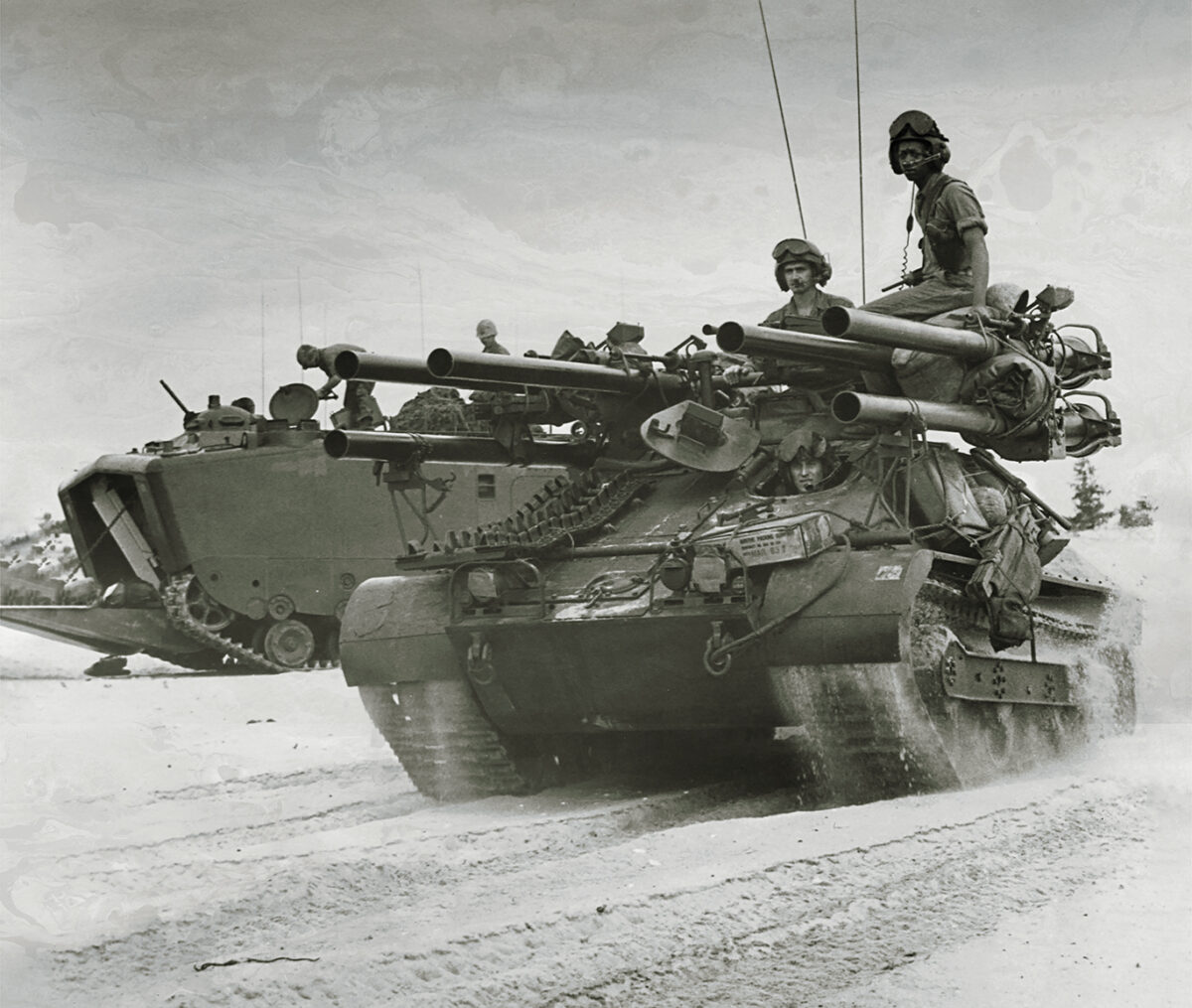As dawn broke over Quang Ngai Province on Aug. 18, 1965, the political officers of the 1st Viet Cong Regiment looking on from the village of Van Tuong were startled to see an American naval force anchored just off the South China Sea coast. Within an hour, landing craft began disembarking riflemen from 3rd Battalion, 3rd Marine Regiment onto the shore—dubbed Green Beach—adjacent to the small fishing village of An Cuong.
Four miles west, on a swath of land pummeled by artillery, airstrikes, naval gunfire, and napalm, Marines from 2nd Battalion, 4th Marine Regiment were lifted by helicopter into three north-to-south landing zones at one-mile intervals. The 3rd Battalion’s M Company moved south from the Marine air base at Chu Lai and established a mile-long blocking position north of the engagement area by 4 a.m. that day.
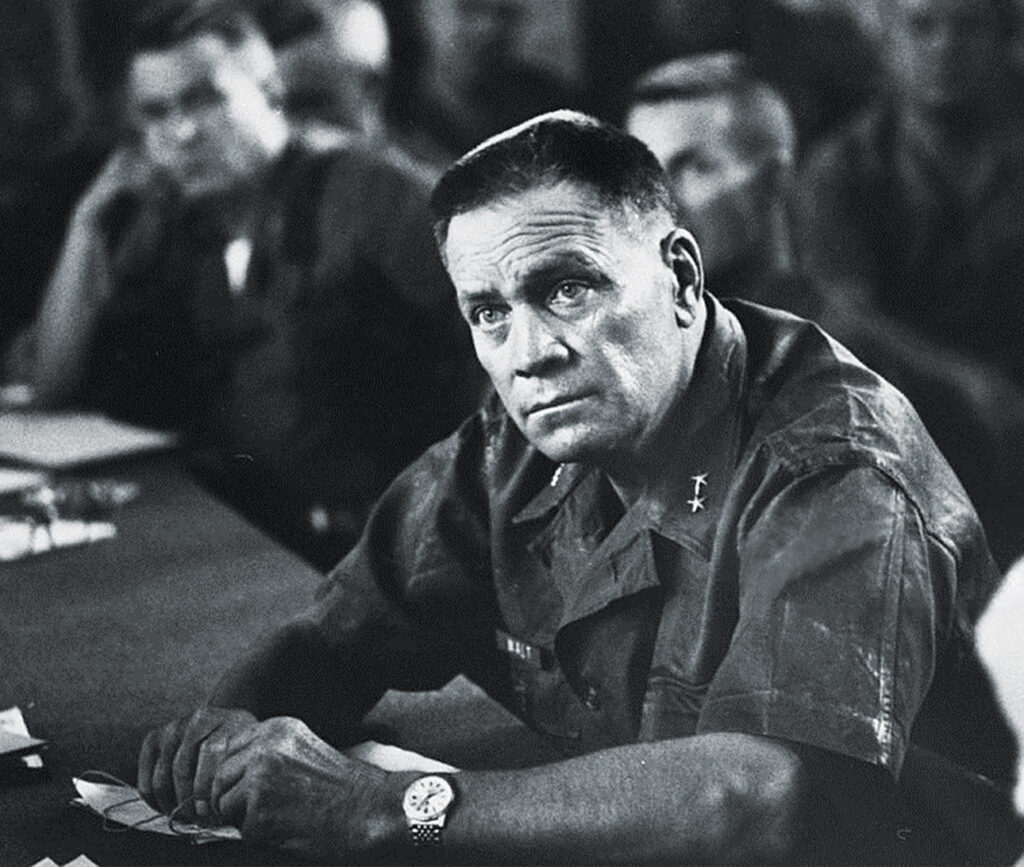
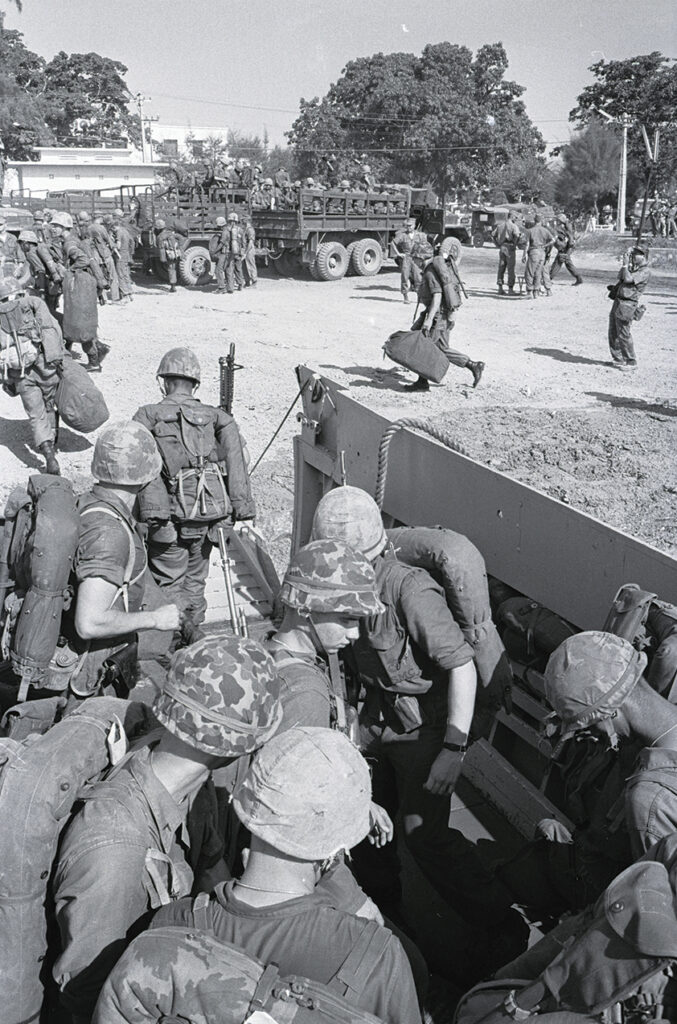
With his “anvil and hammer” pieces in place, Lt. Gen. Lewis Walt’s Operation Starlite was underway. Attacked and pursued eastward, the Viet Cong would be unable to escape by sea. They would have to stand and fight or attempt to escape and evade.
Operation Starlite took place when it did for two reasons. Gen. William Westmoreland, commander of U.S. Military Assistance Command Vietnam (MACV), had made it clear by early August 1965 to Walt, commander of III Marine Amphibious Force, that he expected Marine infantry units to conduct “major combat operations” against communist forces throughout the I Corps Tactical Zone without delay. A 17-year-old deserter from the 1st VC Regiment surrendered on Aug. 15. This man was personally interrogated by Maj. Gen. Nguyen Chanh Thi, commander of I Corps. Thi was convinced of the deserter’s claims that the 1st VC Regiment was based in Van Tuong and planned to attack the air base at Chu Lai, and he immediately notified Walt. When American intelligence confirmed the presence of insurgents in the area, Walt acted immediately, leaving Aug. 16-17 for planning and preparation. He planned the attack for 6:30 a.m. on Aug. 18.
Not all the deserter’s claims proved accurate. The 1st VC Regiment had just concluded a successful summer campaign. By late July, its four dispersed battalions had infiltrated northward into base areas around Van Tuong 1, Nam Yen 3, and elsewhere, and had no plans to attack Chu Lai. The 1st VC Regiment—the 40th, 60th, 90th, and 45th Weapons Battalions—was a well-armed and seasoned force led by a veteran cadre that had scored repeated victories over ARVN forces in the last half of 1964 and first half of 1965. On July 5, 1965, it had overrun and almost annihilated the 1st Battalion, 51st ARVN Regiment at Ba Gia 20 miles south of Chu Lai, but had also suffered extremely heavy losses and needed time to rest, refit, and begin recruiting and training new conscripts.
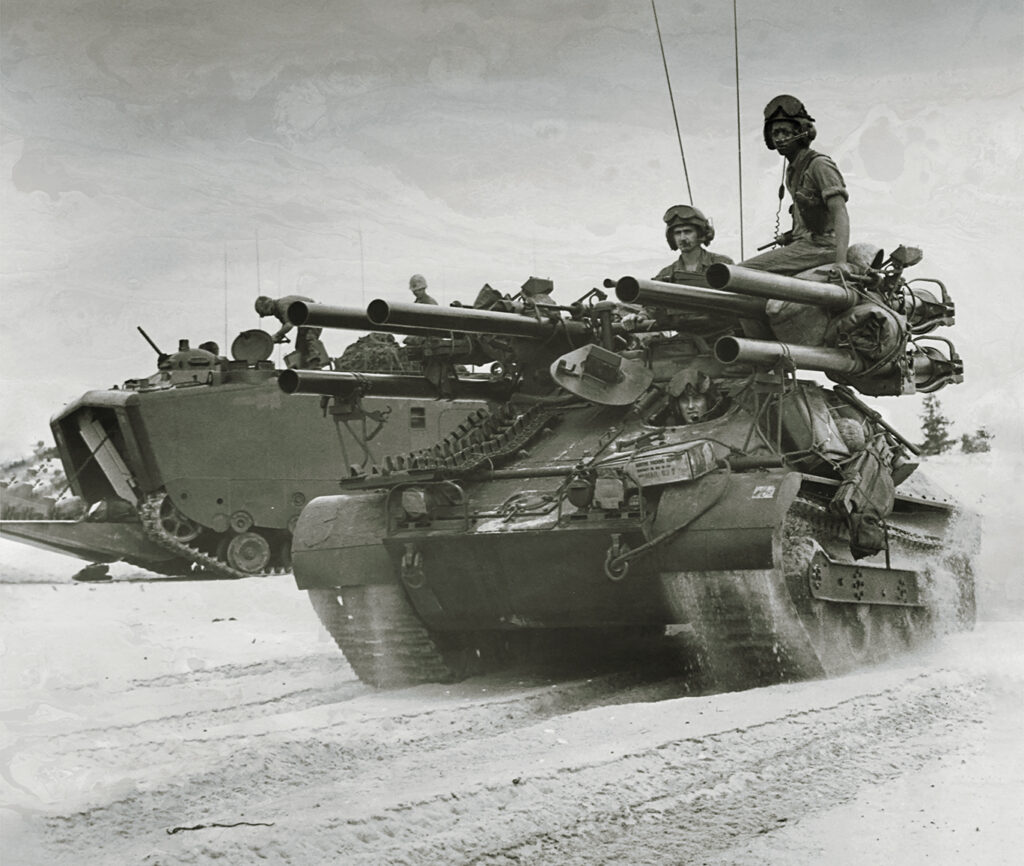
The Marines were unaware that elements of the 2,000-man enemy regiment were absent. The 1st VC Regiment’s commander, Le Huu Tru, his deputy, and the battalion commanders were attending a post-campaign conference in the mountains west of Chu Lai, leaving command to political officers, while the 90th and half of 45th Weapons Battalion were still 15 kilometers south of the engagement area. The remainder of 45th Battalion, along with 40th and 60th Battalions, would be present in the battle area on Aug. 18 with 1,500 men at most.
With the regimental command post located at Van Tuong 1 just four kilometers from Green Beach, Nguyen Dinh Trong, the 1st VC Regiment’s top political officer, moved to delay the Marines while the command post was either reinforced or relocated. Duong Tong Minh set up a defensive position in a trench halfway between Green Beach and Van Tuong 1, then moved close to the beach and prematurely detonated a mine in the path of the oncoming Marines that did no damage. Lt. Phan Tan Huan prepared a defensive position south of An Thoi 1, from where he would direct 57mm recoilless rifle, machine gun, mortar, and small arms fire at any Marine unit within range.
Hostilities commenced in earnest when Companies K and I, 3rd Battalion, 3rd Marine Regiment disembarked from LVTP-5s (Landing Vehicle, Tracked, Personnel 5, also called amphibious tractors or “amtracs”) and advanced abreast toward An Cuong 1. On the right, Capt. Jay Doub’s three platoons of K Company came under automatic weapons fire and called in airstrikes, then moved forward and cleared the northern third of the village.
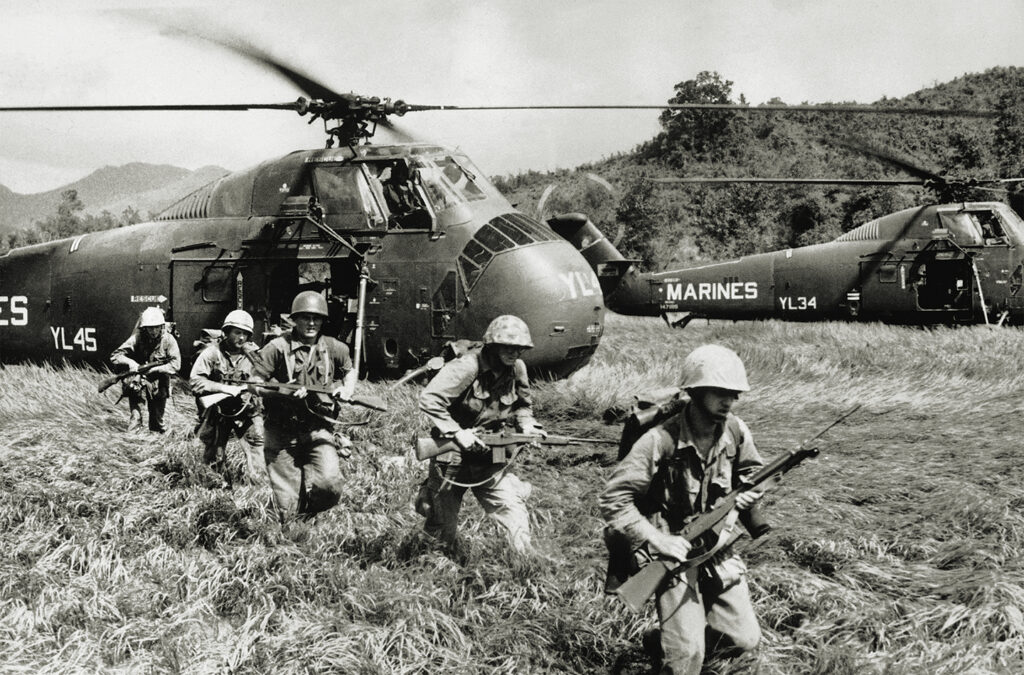
Backed by two M50 Ontos fighting vehicles, K Company’s platoons continued west and secured the high ground beyond the village.
The M50 Ontos was a tracked, lightly armored anti-tank vehicle boasting massive firepower. It was equipped with six 106mm recoilless rifles, a .30-caliber machine gun, and several .50-caliber “targeting” guns; the .50-caliber M-8C spotting rifle for the 106mm M-40 recoilless rifle was not a machine gun, but a magazine-fed single shot that fired a special marking round. The M50, used by the Marines as an anti-personnel weapon, struggled in harsh terrain; crew members were exposed to enemy fire when they had to leave the vehicle to reload the rifles.
K Company pivoted right and advanced northward toward Phase Line Banana. On the left, I Company, 3rd Battalion, 3rd Marine Regiment, cleared the rest of the village and continued westward to link up with 2nd Battalion, 4th Marine Regiment a mile inland near An Cuong 2.
On Green Beach, Lt. Col. Joseph Muir, commanding officer of 3rd Battalion, 3rd Marine Regiment, had moved his command post ashore and was joined there at 7:30 a.m. by Col. Oscar Peatross, CO of 3rd Battalion, 7th Marine Regiment and overall commander of Starlite’s ground forces. Capt. James McDavid led L Company, 3rd Battalion, 3rd Marine Regiment ashore at 7 a.m. and had his three platoons spread out on the battalion’s right flank and dig in.
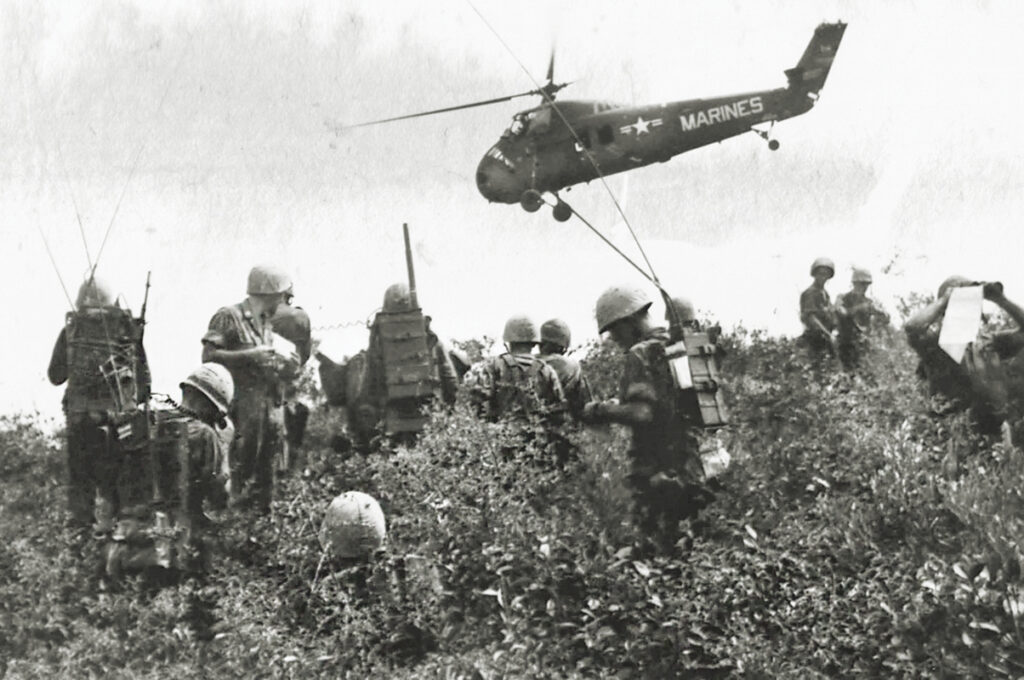
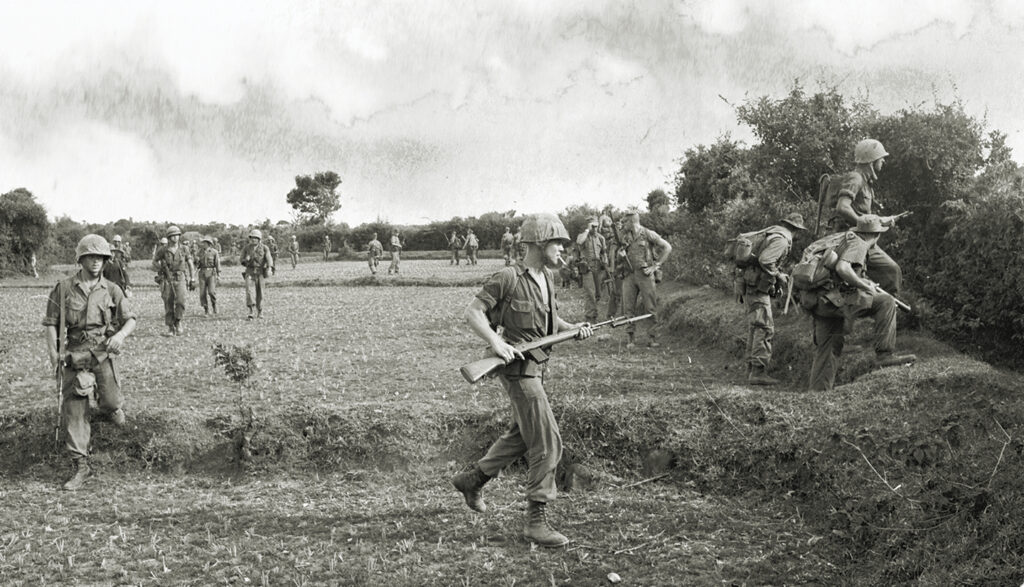
At 6:45 a.m., UH-34 helicopters shuttled G Company, 2nd Battalion, 4th Marine Regiment into Landing Zone (LZ) Red, while E Company, 2nd Battalion, 4th Marine Regiment and Lt. Col. Joseph Fisher’s battalion command post landed at LZ White at 7:45 a.m.
The eight-hour ordeal of H Company, 2nd Battalion, 4th Marine Regiment began when it landed at LZ Blue onto ground occupied by 1st VC’s 60th Battalion. LZ Blue lay in an exposed position between Nam Yen 3 and Hill 43, a wooded knoll dominating the otherwise flat terrain. The enemy allowed the first wave of helicopters to land unmolested. Afterwards the Viet Cong poured .51-caliber (Soviet 12.7mm) heavy machine gun fire into the succeeding waves and into the Marines working feverishly, in merciless 105-degree heat, to establish a perimeter around the landing zone.
As the fighting escalated around LZ Blue, the companies farther north made good progress. G Company, 2nd Battalion, 4th Marine Regiment left LZ Red and searched two nearby hamlets, found nothing, and continued pushing steadily eastward against light resistance. They eventually dug in on M Company, 3rd Battalion, 3rd Marine Regiment’s right flank at PL Banana.
Advancing northeast from LZ White for 200 meters, E Company, 2nd Battalion, 4th Marine Regiment came under mortar, machine gun, and small arms fire from an estimated 70 insurgents on a ridgeline to their front. Thanks to the lavish use of supporting arms—particularly Marine A-4 Skyhawks and F-4 Phantoms rocketing, strafing, and napalming the enemy—the company fought their way up the ridge and cleared it, evacuated casualties for an hour, and continued north at around 11 a.m. At noon, they made contact with 50 more insurgents. Another firefight ensued.
Advancing, E Company spotted a force of about 100 insurgents in the open, heavily armed and moving briskly south. The timing was auspicious. Whiskey (“Howtar”) Battery, 3rd Battalion, 12th Marine Regiment had been lifted via helicopter into M Company, 3rd Battalion, 3rd Marine Regiment’s position that morning. The 20-round barrage it delivered killed about 90 of the enemy. (A “howtar” is a hybrid 107mm shell mounted onto the platform of a 75mm pack howitzer.) By 3 p.m., E Company, 2nd Battalion, 4th Marine Regiment had fought its way to PL Banana with moderate losses and was settling into defensive positions.
Around noon, Muir ordered his executive officer, Maj. Andrew Comer, to send a resupply column to I Company, 3rd Battalion, 3rd Marine Regiment, then a few hundred meters north of Muir’s command group. Comer assembled three M67 “Zippo” flame tanks (napalm only), five amtracs loaded with ammunition and water, and 23 Marines led by 2nd Lt. Robert Cochran. Column 21 moved out at 12:30 p.m. The convoy had advanced only a few hundred meters between Nam Yen 3 and An Cuong 2 along a trail flanked by rice paddies and trees, dikes, and hedgerows, when a mortar disabled the lead tank. The entire column then came under a devastating barrage that killed Lt. Cochran and halted the advance. Trapped inside their amtracs and tanks, the Marines returned fire with every weapon at their disposal. Yet by late afternoon most of the armored vehicles had been disabled, casualties were high, and the column was down to just one vehicle-mounted automatic weapon returning fire.
Sgt. James Mulloy, who later said he could see “hundreds of insurgents in every direction,” abandoned his amtrac, hid in a nearby paddy, and kept up a steady stream of M-14 rifle fire that stymied repeated enemy attempts to overrun the convoy. The column’s radio operator, panicking, kept his handset keyed on “send,” blocking incoming calls requesting detailed information. Due to communications problems, Column 21 couldn’t be located and remained in place until it was extracted the next morning. The enemy unit that launched the ambush, 1st Company, 40th VC Battalion, also suffered severe losses due to their habit of attacking in large, close formations.
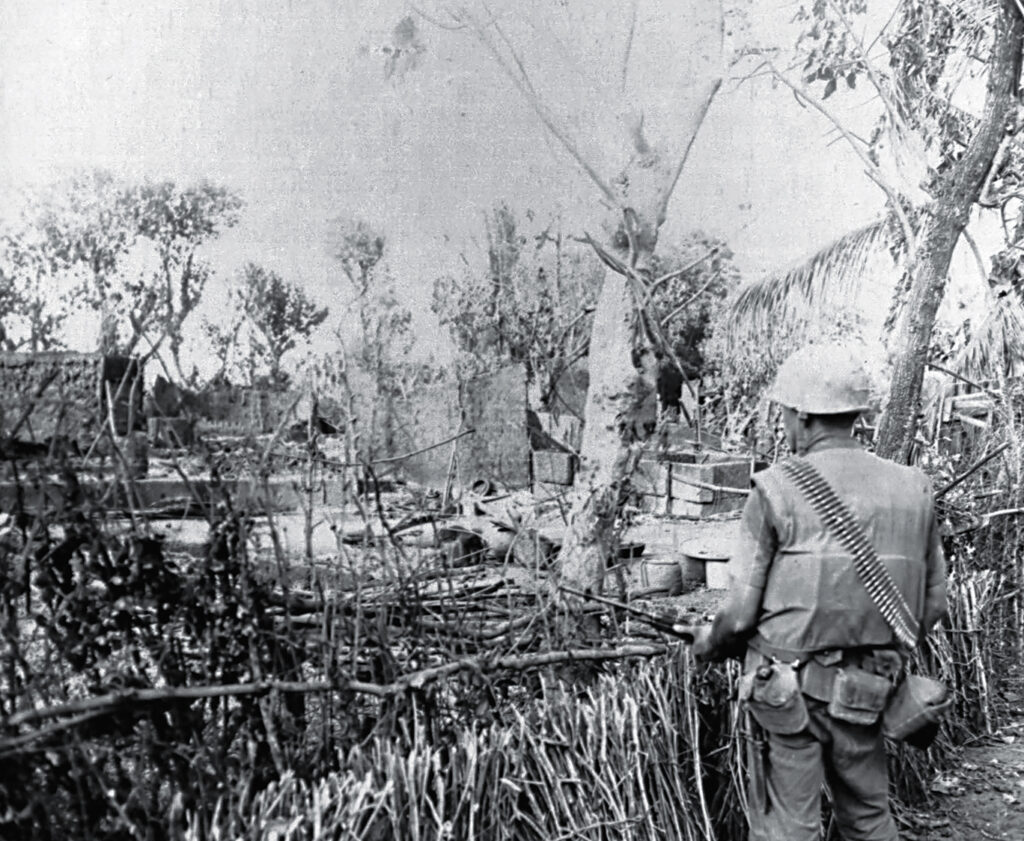
K Company, 3rd Battalion, 3rd Marine Regiment had advanced two kilometers northward when both 2nd and 3rd Platoons, save one squad led by Lt. Burt Hinson, were pinned down by heavy fire coming from trench lines to their front and left flank. Firing his .45-caliber M1911A1 pistol, Lt. Hinson led his lone squad on a charge up the slope to their front, driving the surprised insurgents and their automatic weapons from the crest of the hill. After 1st Platoon captured the enemy trench on the left flank, the pressure along the entire front was relieved. After Muir ordered L Company, 3rd Battalion, 3rd Marine Regiment, to come up from Green Beach and deploy on K Company’s right, the two companies continued northward. By 1 p.m. they were setting up defensive positions along PL Banana.
Unsure of the enemy force’s size, 1st Lt. Homer Jenkins, commanding H Company, 2nd Battalion, 4th Marine Regiment, ordered one platoon to attack Hill 43 and two platoons to attack Nam Yen 3. Both thrusts were easily halted. Jenkins called in airstrikes and led an attack against Nam Yen 3 with all three of his platoons. An entire enemy company occupied the village. As 3rd Platoon moved forward, it was hit by a fury of automatic weapons fire from a VC-occupied hedgerow. Although the Marines killed a number of insurgents and captured the hedgerow, H Company was unable to suppress the torrent of enemy fire and could advance no further into Nam Yen 3. Lt. Jenkins regrouped his company and led another attack against Hill 43, and with the help of M48 Patton tanks finally captured the crest of that hill. Needing more Marines on the ground, Col. Pea-tross summoned one company from his reserve, I Company, 3rd Battalion, 7th Marine Regiment.
The airstrikes called by Lt. Jenkins had halted the advance of Capt. Bruce Webb’s I Company, 3rd Battalion, 3rd Marine Regiment east of Nam Yen 3. When the barrage lifted, I Company continued to its assigned position opposite An Cuong 2, only to come under fire from An Thoi 2 and from high ground southeast of An Thoi 1.
Aware the company to his left, H Company, 2nd Battalion, 4th Marine Regiment, was in difficulty, Webb asked permission to attack An Cuong 2, though it was in 2nd Battalion, 4th Marine Regiment’s area of responsibility. Muir assented.
Webb and his men advanced and encountered a fortified village numbering about 25 huts, honeycombed with dozens of camouflaged trenches, tunnels, bunkers, spider holes, and huts with collapsing walls that allowed machine gun teams inside to open fire when the walls were lowered. The terrain was marked by dense vegetation, rice paddies, and wooded areas, leaving the Marines few open fields of fire. Hedgerows and thickets measuring six to eight feet high divided the rice paddies, providing the defenders with excellent cover and concealment.
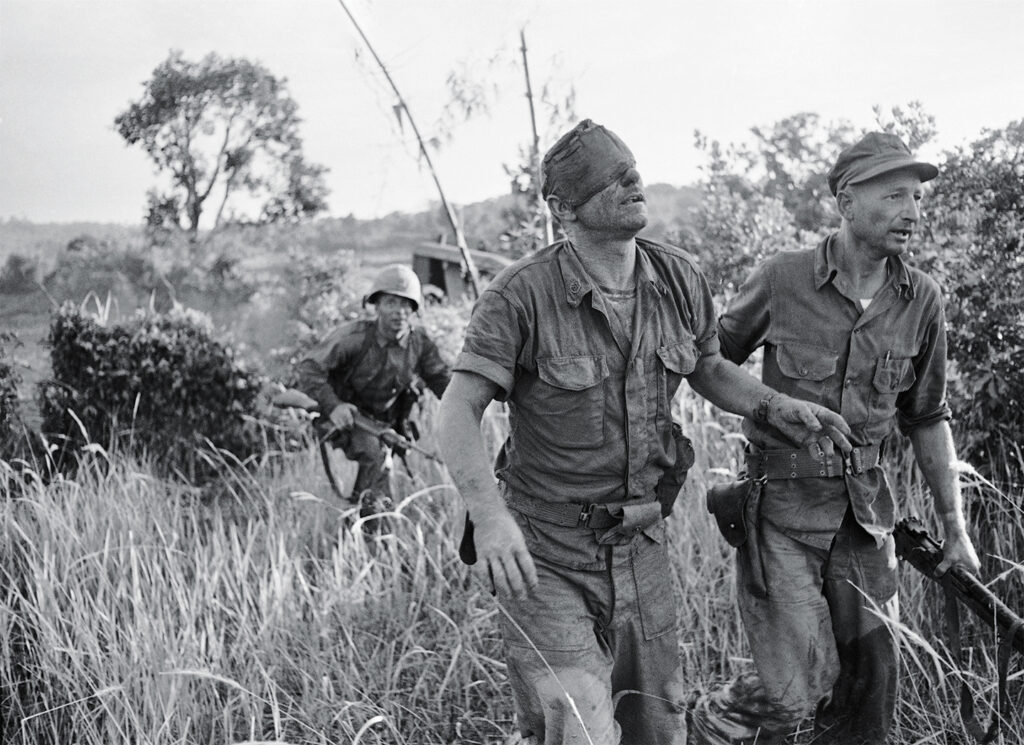
I Company, 3rd Battalion, 3rd Marine Regiment, had just entered the village when a grenade killed Capt. Webb and mortar fire wounded nine others. 1st Lt. Richard Purnell, the company’s executive officer, assumed command and called the reserve platoon forward. Again, armor and supporting arms turned the tide, helping I Company to capture An Cuong 2 and kill 50 insurgents in 90 minutes of fighting. Purnell radioed Muir and was told to resume his march north toward PL Banana. As I Company departed, a helicopter gunship was shot down northeast of the village, and on Muir’s orders Lt. Purnell left 10 men and three tanks to protect the craft until it was evacuated.
With Hill 43 secured, Lt. Jenkins regrouped H Company and renewed the assault against Nam Yen 3, backed by two flame tanks and three M50 Ontos. The advance was again halted, however, by intense fire from hedgerows on both flanks, with the insurgents now adding white phosphorus rifle grenades to the barrage. In the debilitating heat, a good number of Marines spent their water supplies and began suffering from exhaustion and dehydration.
Carrying their dead and wounded, I Company, 3rd Battalion, 3rd Marine Regiment arrived at PL Banana around 1 p.m. The company’s tired Marines got almost no rest as they were called back to the regimental command post to help search for Column 21, the “lost column.”
Notified the column had been ambushed, Muir ordered Maj. Comer to gather whatever support he could and move to the convoy’s aid, with I Company, 3rd Battalion, 3rd Marine Regiment leading. Comer’s rescue column—one tank, five amtracs, three Ontos, and most of Lt. Purnell’s I Company riding aboard the vehicles—left the command post around 1:30 p.m., unaware of the convoy’s location and unable to make radio contact.
After Comer’s column traveled just 400 meters and reached high ground 200 meters east of An Cuong 2, a projectile halted the lead tank. The bunched-up column came under a fierce barrage of enemy fire that killed five Marines and wounded 16. Much of the fire came from An Cuong 2, which had been “cleared” earlier in the day, after the enemy had reentered the village through a hidden tunnel network. After calling in airstrikes, the men of I Company again found themselves battling an enemy hidden in trenches and hedgerows surrounding the village.
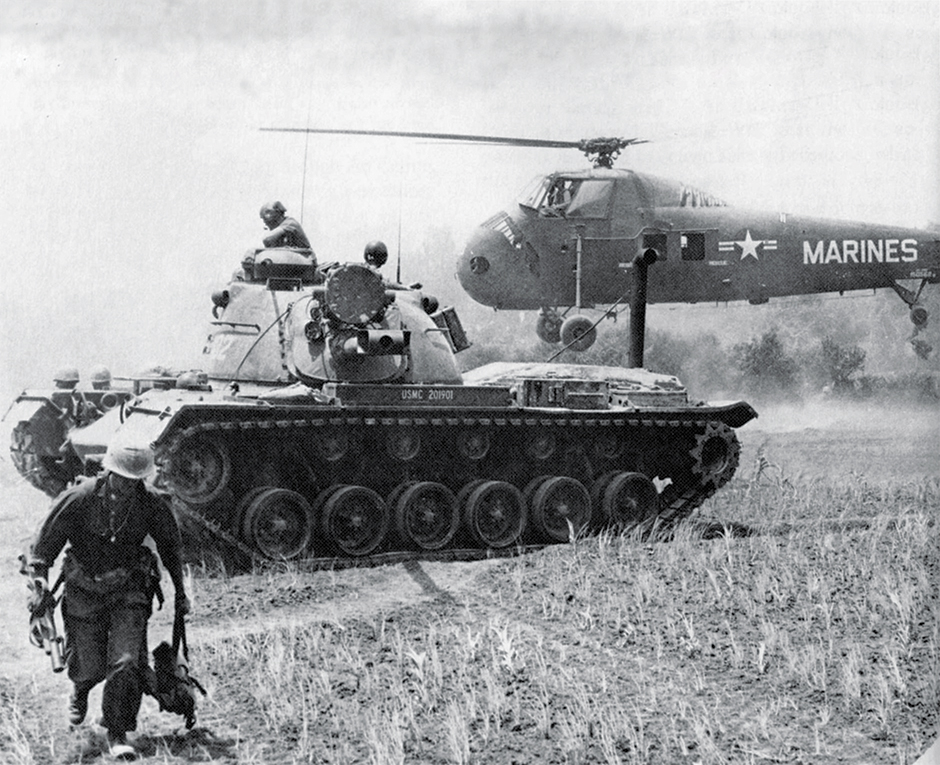
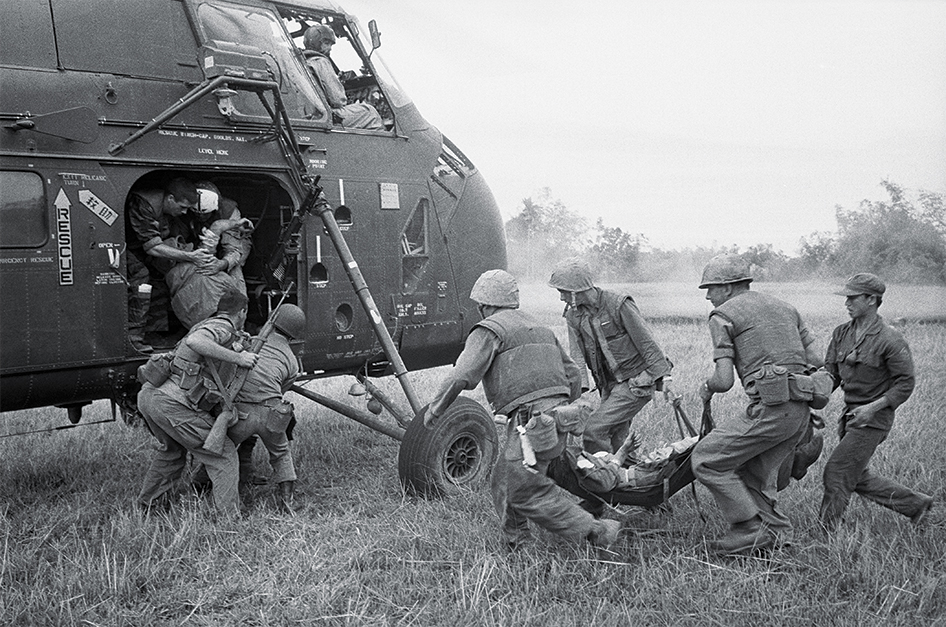
Tank fire set the hedgerows aflame, adding smoke and dust to the haze blanketing the battlefield. Reinforced by L Company, 3rd Battalion, 7th Marine Regiment and two more tanks, I Company fought its way through An Cuong 2 as darkness fell on Aug. 18 and then searched unsuccessfully into the night for the lost supply column. Muir called off the rescue when he learned the column was no longer in danger and ordered L Company to join the regiment at PL Banana. The exhausted Marines of I Company finally returned to the command post at 4:30 a.m., having fought for almost 24 hours while losing 15 dead and 55 wounded from their original 177-man contingent.
With Nam Yen 3 quieted by airstrikes, Lt. Jenkins gathered his company and armor—five tanks and three Ontos—and headed northeast for PL Banana. Around 11:30 a.m., he led the company into an open rice paddy between Nam Yen 3 and An Cuong 2 and quickly came under small arms and machine gun fire. With mortars raining down on the entire column, H Company, 2nd Battalion, 4th Marine Regiment found itself under fire from all directions and with no room to maneuver. With his position untenable, Lt. Jenkins finally received orders to withdraw to LZ Blue at 2 p.m.
After Jenkins and H Company moved out, their lead platoon had to alter course when medevac helicopters landed in the midst of the column. Moving to the flank, the platoon lost contact with the main body and was ambushed. Fortunately the men were able to link up with Lt. Purnell’s helicopter security detail, after which the combined force fought its way to safety. Jenkins and his two remaining platoons fought through several additional ambushes and arrived at LZ Blue at 4:30 p.m., where he was ordered to dig in and await resupply and reinforcements.
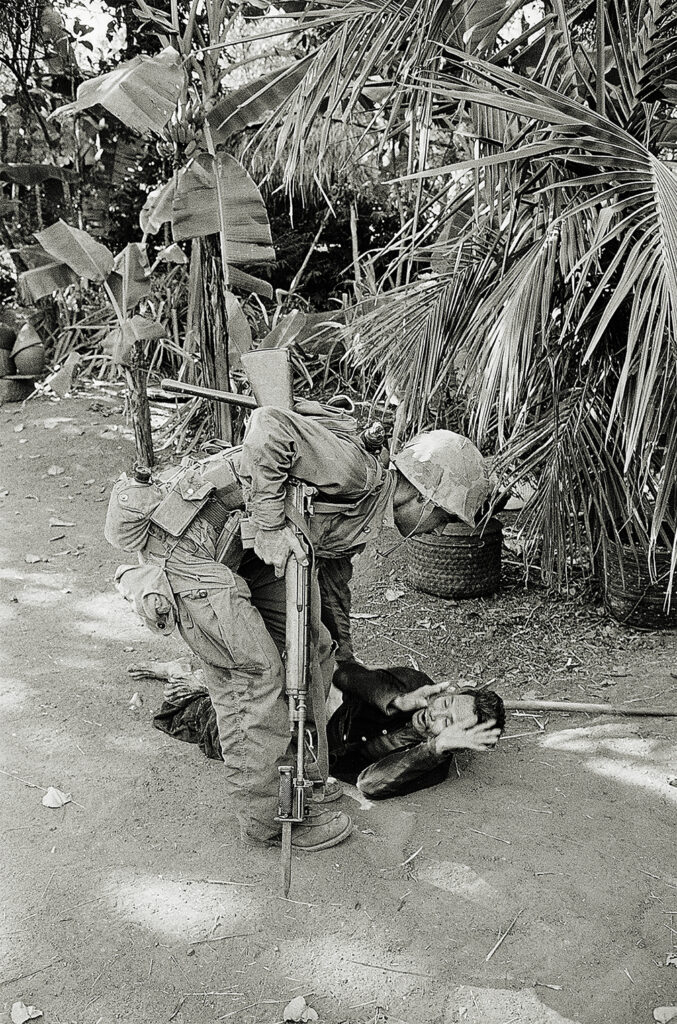
After eight hours of almost constant combat in crippling heat and humidity, the parched and exhausted Marines of H Company welcomed the rest. Though they hadn’t achieved their objectives, they had killed a good number of enemy soldiers.
The Marines spent the night of Aug. 18 shoring up their lines while Col. Peatross brought the rest of 3rd Battalion, 7th Marine Regiment ashore. Muir and Fisher found only scattered pockets of resistance when they attacked at 7:30 a.m. on Aug. 19. Snipers holed up in caves and spider holes continued to harass Marine patrols.
As the Marines moved into the area of the previous day’s heaviest fighting, they found 1st VC had largely escaped during the night, leaving one company behind to assist the villagers with casualties. M and I Companies, 3rd Battalion, 7th Marine Regiment, pushed through An Cuong 2 with no resistance, brought out the lost supply column, and established a blocking position outside An Thoi 2 by 3 p.m. By nightfall, the Marines had completed their sweep of the Phuoc Thuan Peninsula and organized resistance had ceased.
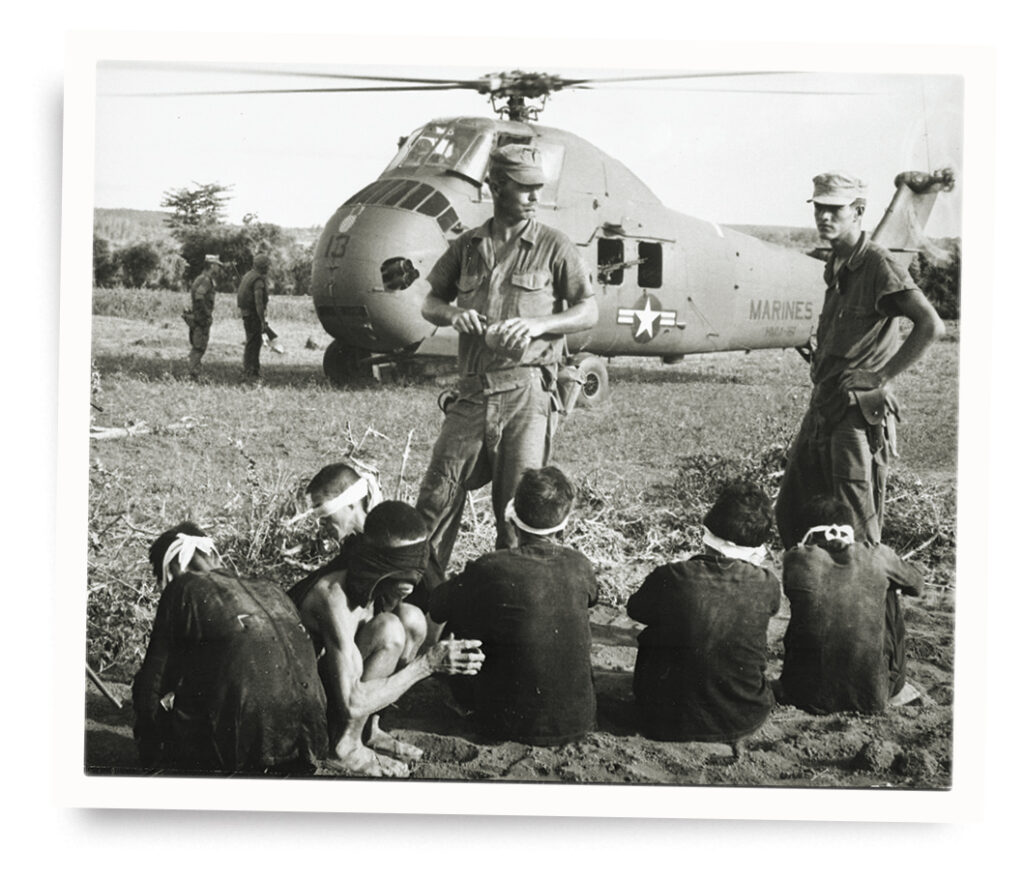
Due to the presence of so many hidden tunnels, bunkers, caves, spider holes, and machine gun emplacements discovered in and around Van Tuong 1, Gen. Walt continued the operation for another five days (Aug. 20-24) to conduct a thorough search. After 2nd Battalion, 4th Marine Regiment and 3rd Battalion, 3rd Marine Regiment returned to Chu Lai on Aug. 20, the men of 1st Battalion, 7th Marine Regiment moved into the area and joined 3rd Battalion, 7th Marine Regiment and units from the ARVN’s 2nd Division for the search. The Marines killed another 54 enemy soldiers before Operation Starlite concluded on Aug. 24, bringing the total of confirmed Viet Cong dead to 614, along with nine prisoners of war and 42 suspected insurgents at a cost of 45 Marines killed in action and 203 wounded. Although both sides claimed victory, the Marines were more than satisfied with the results of what became the war’s first major U.S. offensive and the war’s biggest battle to date involving American troops.
The Marines had killed a disproportionate number of enemy soldiers fighting from expertly camouflaged, prepared positions in extremely harsh terrain, had overcome extreme weather conditions and communication difficulties, and had evicted, at least temporarily, a formidable enemy regiment from its stronghold in and around Van Tuong 1.
Although the speed with which 1st VC Regiment replenished their ranks and returned to the battlefield shocked the Marines, their hard-fought victory bolstered their confidence that American firepower, technology, and determination would eventually triumph over a tenacious, highly skilled enemy.
John Walker served in Vietnam July 1970–June 1971 with the 173rd Airborne Brigade in Binh Dinh province. He lives in Oceanside, California.
This story appeared in the 2023 Summer issue of Vietnam magazine.
historynet magazines
Our 9 best-selling history titles feature in-depth storytelling and iconic imagery to engage and inform on the people, the wars, and the events that shaped America and the world.


